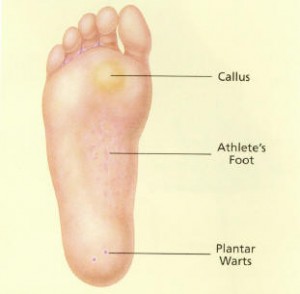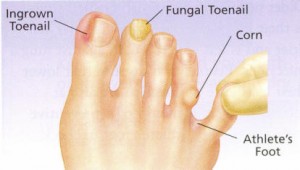Athlete’s Foot

Athlete’s foot is a common fungal infection of the feet, usually occurring between the toes.
What causes athlete’s foot?
It is caused by a fungus that becomes active when exposed to a warm and humid environment or when there is a change in the condition of the skin. Athlete’s foot is not found just in locker rooms. Any moist environment will harbor fungi. Shoes and socks provide a good breeding ground because they tend to accumulate perspiration and moisture.
How do I know I have athlete’s foot?
Symptoms include skin pain, burning and itching, cracking and scaling, and swelling.
Can I get athlete’s foot if I’m not an athlete?
Anyone can get athlete’s foot. Some people are more prone to fungal infections because of their age, heredity or health condition. Older people are more susceptible because, as their skin ages, it becomes thinner and drier and is less able to guard against fungal infections. People with diseases that lower their resistance to infection are also at increased risk and should take preventive measures to keep athlete’s foot in check.
Warts
Warts are skin growths. They can appear anywhere on your feet, but most commonly grow on the soles (planter warts). Most warts are harmless and benign (non-cancerous), although they can be painful. If untreated, warts can grow to an inch or more in diameter and cover the entire sole of the foot.

What causes warts?
Warts are caused by a virus. Like all viruses, they are contagious and can be spread from one person to another, or from one part of the body to another. Children and teenagers tend to get warts more often than adults. Some people are immune and will never develop warts.
What do warts look like?
Planter warts are hard and flat, with a rough surface and well-defined boundaries. Most are gray or brown with black pinpoints in the center.
How can I treat a wart?
Warts sometimes may spontaneously disappear and later reappear in the same location. Treatment may include over-the-counter medications or a simple surgical procedure. If left untreated, warts can grow to an inch or more in diameter and can spread into clusters of several warts.
Ingrown Toenails
Ingrown toenails occur when a nail curves down at the sides and grows into the skin. This can be painful and invite infection. Ingrown toenails happen most often to the big toe. Symptoms: Redness, swelling and infection make the toe very painful.
What causes ingrown toenails?
Ingrown toenails are often caused by improper trimming. They can also be caused by crowding of toes or pressure in shoes, repeated trauma to the feet from normal activities, or heredity.
How can I prevent ingrown toenails?
It’s most important to trim nails carefully with clean, sharp toenail clippers. Avoid injuring the adjacent skin.
How can I treat an ingrown toenail?
Don’t attempt to remove any part of an infected nail and don’t use over-the-counter medications. Contact Rhinebeck Foot Care, if nail continues to grow inward despite proper trimming.
Blood (Hematoma) Beneath The Nail
A very common result of active lifestyles in blood, or a hematoma, beneath the toenail. Hematomas are especially common among people who jog or play tennis, caused by the toes repeatedly rubbing against the shoe. A hematoma might indicate a fractured bone, especially after an injury (such as dropping a heavy object on the end of the toe). The toe should be examined, and maybe x-rayed, to determine the most appropriate treatment.
Some treatment options include: drilling a tiny hole into the nail plate to release the blood and relieve the pain; the nail plate may be removed, so that the nail bed can be cleaned (sometimes this is preferred, because the blood can attract fungi and lead to infection). Nail plates that have been removed will grow again within three to six months.
